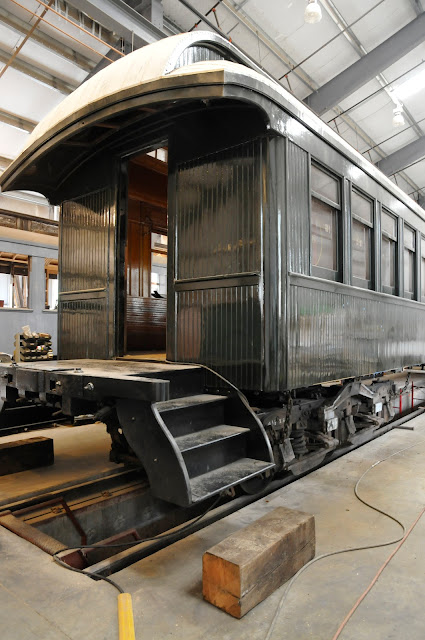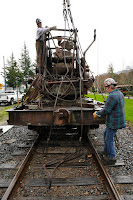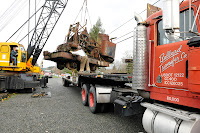Thank you to all our Volunteers, Donors, Trustees, Supporters, Members, Benefactors, and Patrons for a wonderful and successful 2012.
A railway museum is about more than just the excitement of a train: it is education, heritage and historic preservation, community identity, the economic sustainability of a small community, and enjoyment. Thank you to everyone who played a part in 2012.
2013 will bring many exciting developments to the Museum: completion of the chapel car, improvements to the interpretive railway, and expanded educational programs. We all look forward to welcoming you back to the Museum next year!
--Staff of the Northwest Railway Museum: Richard, James, Cristy, Jennifer, Jen, and Jessie.
Monday, December 24, 2012
Friday, December 14, 2012
A 12/12/12 marriage to remember
 |
Messenge of Peace trucks and car body married again!
|
Chapel car 5 Messenger of Peace has wheels again! Messenger of Peace was married with a pair of passenger
car trucks in a lengthy ceremony held on the much-coveted 12 December 2012, or
12/12/12. The car lost its original
trucks in 1949 when it was adapted for reuse as a roadside diner. The rehabilitation work it is undergoing
inside the Museum’s Conservation and Restoration Center includes elements of
restoration, including the trucks.
 |
The car body underside showing the
centerplate.
|
Railway car trucks are assemblies that include a frame,
wheels, bearings, brakes, and a mounting plate for the car body. For the chapel car, these trucks each have
six wheels and are constructed predominantly of wood. A blog post describing the removal process is
here.
 |
Car body centerplate and the truck
centerplate slowly come together.
|
Marrying trucks to a car body requires very careful
alignment. For the chapel car, 22 months
of time on car stands had resulted in the car shifting slightly off center. So the rehabilitation crew carefully nudged
the car body back to the center of the tracks in a process that consumed hours. They used a set of hydraulic jacks to undertake this work on the 60,000 lb car body. Certainly a great deal was at stake should the car be knocked off the car stands!
 |
Bob, Kevin and Gary roll the rear truck
under the car body.
|
So 12/12/12 marks a marriage to last: the trucks and the
chapel car car body. And this is both symbolic and indicative of the final stages of this two year project to rehabilitate this national treasure. Stay tuned for more reports about this incredible project!
Tuesday, December 11, 2012
Something old, something new
 |
6 wheel wood, steel reinforced
passenger truck
|
Later this month inside the Conservation and Restoration Center, the chapel car 5 Messenger of Peace will
be married to its new trucks, which are special frames with wheels, bearings,
and brakes. The trucks (we think, based
on castings and other details) date from circa 1901 and will get some new parts,
are in a sense borrowed, and will be carbon black. So how appropriate to now look at the origins
of those trucks and how they compare to the originals.
Messenger of Peace was built by Barney and Smith of Dayton,
Ohio in 1898. The car was one of the
longest cars built to that date and incorporated all the latest design
advances. It included 6 wheel trucks
reinforced with steel flatbars on either side of the oak frame members. Sadly, those original trucks were (we
believe) scrapped in 1948 when the car was repurposed as a roadside diner.
The Museum has several railroad cars it has been holding to
provide parts for others. While most
were originally acquired for the Collection, they were later removed either
because they were redundant or because they were in very poor condition. They
provide couplers, brakes, hardware, and even wood moldings to make objects in
the Collection more complete.
 |
Imhoff Crane lifts the X-127 while the
Museum's Pettibone exchanged the
trucks.
|
A late nineteenth
Century car called the X-127 was one such car.
It was outfitted with trucks of the same design that the chapel car was
built with and they are in great shape.
They received some structural upgrades circa 1927, but are visually
nearly identical to the originals.
Earlier this month, Snoqualmie’s own Imhoff Crane set up at the CRC and made
quick work of the truck exchange. They
lifted the car one end at a time and replaced the original trucks with a set of
shop trucks the Museum uses to move projects around.
So something old (the chapel car), something new (new center
plates), something borrowed and something carbon black (black trucks from
another car) will be in the marriage of chapel car 5 and its trucks. Later, Spike will post some marriage photos
along with the circa 1902 photo taken at Novinger, MO that has been used to
rehabilitate the car.
 |
Perhaps only to a curator's eye, this is a classic wood-era
passenger car truck
|
Saturday, December 1, 2012
Adaptive reuse
 |
Steam crane is prepared
for shipment.
|
The Northwest Railway Museum has offered objects that are
outside its scope of collection or redundant to other museums. Over the last 20 years, more than a dozen
large objects have be sold or transferred to other institutions. And when other museums are not interested,
objects may be offered to a broader audience.
 |
Imhoff's 65 ton conventional crane
makes quick work of lifting the
circa 1903 steam crane.
|
Adaptive reuse is the process of retasking a building or object. It allows something that may have outlived its usefulness and repurposes it for something else. So an old school could become condominium housing. An old caboose could become a cottage or office. And a coal-fired steam crane could become the focal point of a new restaurant development where it supports an outdoor canopy.
 |
Jon Burget poses with
his new acquisition.
|
Snoqualmie’s own Imhoff Crane was hired to lift the vintage crane – all 45,000 pounds of it – and Seattle’s Ballard Transfer was hired to transport it. The move took most of a day and no doubt turned some heads on Interstate 90.
Congratulations to Jon Burget of Pavingstone Supply Inc on the
acquisition of this interesting historical object for his new restaurant. When he opens next summer, Spike will
broadcast the date, time and place so you can see adaptive reuse in
action!
Labels:
Adaptive reuse,
collection management,
crane
Subscribe to:
Comments (Atom)

